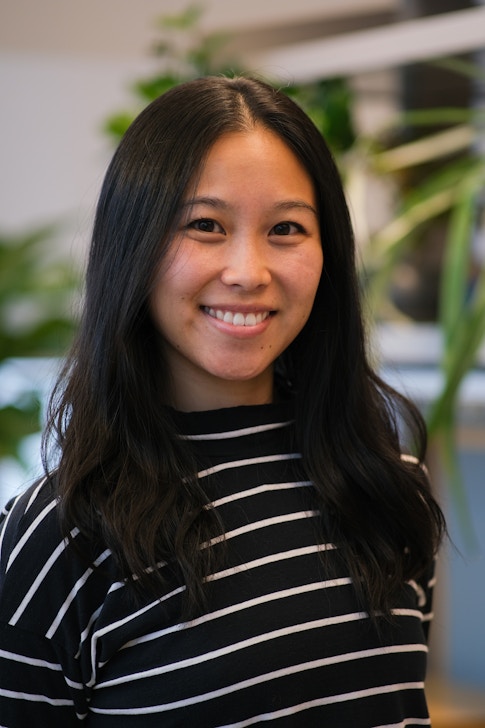What Actually Happens When We Experience Inflammation?

When you experience inflammation, a part of your body may swell, turn red or become very itchy. The effect can be anywhere from uncomfortable to downright painful. But in general — except in certain medical conditions that produce chronic inflammation — these sensations are temporary. They also serve a useful purpose; inflammation is a sign that our bodies are fighting off a bacterial or viral infection. It is a crucial step on the road back to health.
Even though scientists understand the purpose of inflammation, much about what happens within our cells remains unknown. Scientists are particularly interested in the role of cellular proteins and how they respond to an invading bacterium or viral particle. First year Simons Junior Fellow Ashley Chui, a postdoctoral fellow in Michele Pagano’s lab at the New York University School of Medicine, is bringing clarity to our understanding of this process. Chui holds a bachelor’s degree in biochemistry from California State University, Fullerton, and a doctorate in chemical biology from a joint program of Weill Cornell Medical College, Rockefeller University and Memorial Sloan Kettering Cancer Center.
Chui and I recently discussed her work, as well as why clear science communication is important. Our conversation has been edited for clarity.
How would you describe your overall research goals?
In graduate school, I was interested in understanding what happens within our cells whenever our bodies experience inflammation in response to infections. Inflammation is really a signaling process; it lets our cells know that they have been infected, and that it’s now time to mount a defense. Most everything that occurs within us depends on the interactions of different proteins, so in this case I was studying the activity of proteins during inflammation. There is a fun word for what I study, actually: inflammasome. Inflamma for ‘inflammation,’ and some for ‘whole complex.’
What drew you to this work?
My undergraduate degree was in biochemistry, and that’s when I spent my first sustained period studying what happens inside cells. It felt like putting together a giant puzzle, and that’s what got me hooked!
That giant puzzle is also why this area of research can take many years of painstaking work. Every time you look inside a cell, the proteins are arranged in a somewhat different way than they were before; it’s like looking at a scrambled egg, versus a hard-boiled egg in which you always know where the yolk and white will be. Depending on when you peer inside, you may not be able to observe the process as it happens. You must be patient, with the confidence that with time and dedication you will solve the puzzle.
What parts of the puzzle have you solved so far?
During my graduate work, my colleagues and I studied how and why the inflammasome forms. We also studied how the inflammasome spurs pyroptosis, the process by which infected cells sacrifice themselves in an explosive, fiery death to slow the infection. (That’s another fun word, actually: pyroptosis, in which pyro means ‘fire’ and tosis means ‘death.’)
To study this, we infected cells with the toxin anthrax lethal factor. Scientists have long known that anthrax lethal factor activates the protein NLRP1 into an inflammasome, and that activation leads to pyroptosis, but details beyond that remained elusive.

Our investigation revealed important answers to these questions. We discovered that the lethal factor directly binds to and chops off one end of the NLRP1 protein. This initiates a degradation of NLRP1 as a whole, which releases the other end of NLRP1 that then triggers pyroptosis.
Eventually the contents of the cell explode — that’s the fiery part — which releases all the contents inside the cell. Neighboring cells take notice; they sense a growing infection and begin to work to eliminate it. The discovery of this stepwise process, which had to the best of our knowledge never before been mapped out, was published in 2019 in the journal Science.
What are you working on now during your postdoctoral fellowship in the Pagano lab?
Since I stumbled into the field of protein degradation from my graduate work in the inflammasome field, I wanted to gain more expertise in that field. I chose to come to the Pagano lab at NYU because Dr. Pagano specializes in the study of ubiquitin ligases. This class of proteins are central to cell division and are also critical components for the recycling of proteins in the cell.
Currently, I am characterizing and studying how ubiquitin ligases regulate several cellular processes, including the cell cycle (which regulates how often cells grow and divide), metabolism and signaling processes (or how a cell communicates). Importantly, I’m trying to find the proteins that ubiquitin ligases target for degradation, called substrates. If you can find these, you’ll know how the ubiquitin ligases can regulate the pathways these substrates are involved in.
Finally, how has the Simons Junior Fellowship helped your work?
Right now, I’m in the second year of my postdoctoral training and my first year as a Junior Fellow. Like all other Junior Fellows, I am very grateful for the foundation’s support. It’s wonderful to be part of such a truly interdisciplinary community that studies everything from pure mathematics to astrophysics to my own work in biochemistry.
I believe strongly in the value of clear science communication. It’s important to be able to explain any concept to anyone clearly and in an engaging way, no matter their background, and to do so accurately. When I was in college, I taught high school students about proteins by using analogies, likening them to Twizzlers, for example! That was challenging, but I did it.
Now at the Simons Foundation, I have a similar challenge: I must be able to communicate my work with verve and accuracy to the other Junior Fellows, each of whom is an eminent expert in their field but may not know anything about mine. I’m looking forward to this important opportunity to share my work with this audience.